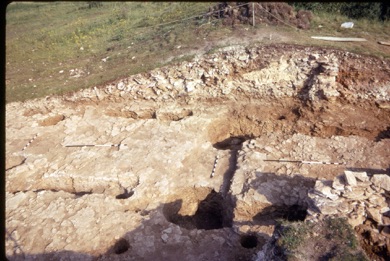Copyright (c) The Crickley Archaeological Hill Trust 1969-2021. The right to use, copy, distribute or otherwise disseminate this material is reserved to those specifically authorised by The Trust.



The first Iron Age hillfort

There seem to be no settlement remains associated with much of the Long Mound use. The next time the hill was settled was in the early Iron Age, about 700-650BC, and the hill, a promontary sticking out from the edge of the Cotswolds, was a natural site for a hillfort. In addition, it seems that a highway ran across the spine of the hill, making this a specially strategic point.
It was at this period that the main rampart - the most striking surviving monument on the hill - was first constructed. It seems is was always most impressive at the entrance side, where visitors still approach the site. Its wall was reinforced with timber lacing and there was a large gateway (see postholes below). Behind the rampart a line of four-posted wooden towers allowed slingers to fire over the rampart.
Inside the rampart was a settlement of longhouses, the biggest of which approaches 20 metres in length. The remains of numerous large postholes show us where these buildings were. There were also a large number of four-posted structures which are usually interpreted as grain stores. While perhaps no more than 100 people lived in the site, it seems undeniable that this was a very important, high status site. Nowadays, it might be called a palace. The defences and the buildings inside would have made a clear statement about who lived there.
This phase was probably not used for very long - maybe less than 100 years - although it does seem to have been completed. There is quite good evidence that the building of this hilfort coincided with the destruction of the Sacred Circle and gap in the use of the Long Mound. One thing that is clear is that it ended violently - the site was attacked, captured and expertly and thoroughly destroyed.
Click the photos to see the Iron Age settlements and gateway


